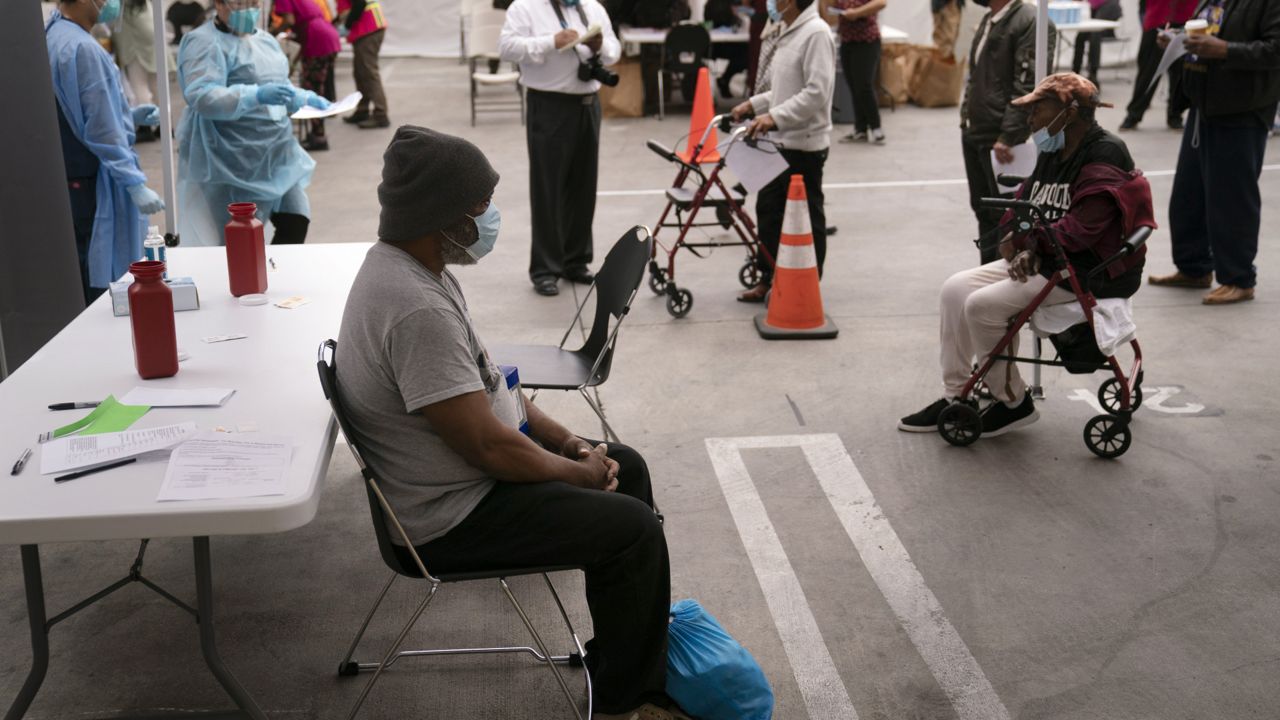LOS ANGELES — The plan for rolling out COVID-19 vaccines to people experiencing homelessness in Los Angeles is slowly moving forward. Even so, one health care provider agreed that the experience of distributing a pandemic-slowing vaccine to transient folks has been a bit like putting the plane together while flying it.
“How do we launch a vaccination program when we’re dealing with a vaccine we’ve never used, one that’s fragile, and time sensitive, and with a community where many of whom are hesitant to take the vaccine?” said Shannon Fernando, the chief innovations officer of Los Angeles Christian Health Centers. Her team manages special clinical programs, including LACHC’s street medicine program.
The logistics are a tremendous complication, Fernando said. Once you puncture a vial, you can’t go anywhere with it — which is a huge issue in street medicine, where staff are often forced to travel to find their patients.
“Every day is a different day,” said Belen Espinoza, who works on LACHC’s COVID response. “Last week was our first week doing this, so we’ve learned a lot,” she said — like creating standby lists, to ensure that even if someone scheduled for an appointment doesn't show up, another person is ready to take that dose of the vaccine. “We’re just rolling with it, and we haven’t wasted any vaccines, which is great.”
That’s significant, considering how many vaccines are readily available in Los Angeles County — apparently, so few that the region’s largest vaccine distribution site at Dodger Stadium was shut down temporarily.
According to the Los Angeles County Department of Health Services, about 600 people — both health care workers and people experiencing homelessness — were provided with the first dose of the COVID-19 vaccine within the last week. Where, particularly, the group of people experiencing homelessness stand on L.A. County’s vaccine distribution tier list is a bit complicated, especially in the wake of the state reconfiguring its plans for prioritization.
Currently, L.A. County is vaccinating people in Phases 1A (healthcare workers, and staff, and residents at skilled nursing facilities and long-term care facilities) and specific people within Phase 1B Tier 1 (residents 65 and older). Other people within Tier 1 — workers at risk of exposure in the education and childcare, emergency services, and food and agriculture sectors — are next on the distribution schedule.
Distribution beyond that is up in the air. According to L.A. County’s Department of Public Health, “the state is most likely going to move to an age based strategy” after completing Phase 1B Tier 1.
But that’s still problematic for a community like people experiencing homelessness. A recent study published by the Los Angeles County Department of Public Health shows that over the past three years, the overall mortality rate for people experiencing homelessness has been three times higher than the general population.
But there are a few issues, providers say. First, the homeless population skews younger than the general population — "it's not like there are a ton of of people who are 65 and older on the streets, because they don't survive," Fernando said. Second, those younger people on the streets end up with health risks as older, housed people.
“We feel strongly that people experiencing homelessness are critical because they are more vulnerable,” said Dr. Heidi Behforouz, the medical director of DHS’s Housing for Health program. Housing for Health has been designated to coordinate the vaccine rollout among people experiencing homelessness. “We feel very fortunate that we’re getting some allotment of vaccines. I think we’re waiting for the vaccine to open up so that we can do more site-based or relationship-based vaccination, as opposed to just vaccinating small cohorts within a community.”
Logistics are the challenge. Right now, DHS is getting about 400 to 500 vaccines a week from DPH. As of the most recent Greater Los Angeles Homeless Count, in 2019, there are believed to be at least 58,000 people experiencing homelessness in the Los Angeles area. With another year and the weight of the pandemic’s economic downturn pressing down, it’s assumed by many that the number of people experiencing homelessness has surged.
“If we’re getting 500 vaccines a week, it’s going to take a long time to vaccinate people. Our hope is that when more vaccines become available, that we can scale,” Behforouz said. To be prepared for that scaling, her organization has submitted for funding to have 22 vaccination teams to fan out across L.A. County. “Our plan is to continue throughout the end of the year,” she said.
But one major concern among advocates for the unhoused is just how many people will be forced out of homes between now and the end of the year.
“Depending on what happens with evictions, there could be a dramatic increase in homelessness…there are tens of thousands of families that are behind in rent, and depending on how that’s treated, there could be a massive increase in the homeless population,” said Adam Miller, the chair of the 1P Foundation, a philanthropic organization that focuses, in part, on finding solutions to the homeless crisis.
“As this pandemic and this new normal continues, I think we’re really concerned about how this is going to affect homelessness in general,” said Jennifer Hark-Dietz, Executive Director of PATH, a service provider that works to help people experiencing homelessness into housing. “Whether or not we’re going to have a huge uptick, we have to have the resources to support all of the people who are going to be at risk or who fall into homelessness. That’s something we’re going to focus on this year and in the next few years as the economy recovers.”
